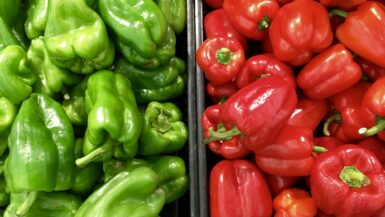Eating in season means consuming fruits and vegetables that are naturally grown and harvested during their specific time of the year. It is a practice that has been followed for centuries, but with the rise of globalization and the availability of food from all over the world, it has become less common. However, eating in season has numerous benefits, both for our health and the environment. In this article, we will explore the importance of eating in season for a healthy diet and why we should consider incorporating seasonal produce into our daily meals.
What does eating in season mean?
Eating in season refers to consuming fruits and vegetables that are naturally ripened and harvested at a specific time of the year. This means that the produce is at its peak in terms of flavor, freshness, and nutritional value. Eating in season requires a shift in our eating habits, moving away from the convenience of year-round access to all types of produce, regardless of where they are grown or when they are harvested. It means consuming food that is grown locally and is available during its natural growing season. Eating in season is a sustainable and healthy approach to diet, and it has numerous benefits for our health, the environment, and the economy.
The benefits of eating in season for your health
Eating in season has numerous benefits for our health. Seasonal produce is fresher, more flavorful, and often cheaper than out-of-season produce. When fruits and vegetables are picked at their peak, they have higher nutrient content, which means that we get more vitamins, minerals, and antioxidants from our food. Eating in season also provides a wider range of nutrients since we tend to eat a variety of produce as the seasons change.
Eating in season also supports our body’s natural rhythms. During the winter, our bodies crave warm, comforting foods like root vegetables and squash, which are abundant during this season. In the summer, we crave lighter, refreshing produce like watermelon and berries, which are in season during this time. Eating in harmony with the seasons can help us maintain balance and optimal health.
Additionally, eating in season can help us avoid exposure to harmful chemicals. When produce is shipped long distances, it is often treated with preservatives and pesticides to prevent spoilage. By eating locally grown, in-season produce, we can reduce our exposure to these chemicals and consume food that is free from harmful additives.
Overall, eating in season is a simple and effective way to improve our health and well-being. It provides us with nutrient-dense, fresh, and flavorful produce that supports our body’s natural rhythms and reduces our exposure to harmful chemicals.
The environmental impact of eating in season
Eating in season is not only beneficial for our health, but it is also beneficial for the environment. When we eat locally grown, in-season produce, we reduce the carbon footprint associated with transportation and storage of out-of-season produce. The transportation of food is responsible for a significant amount of greenhouse gas emissions, which contribute to climate change. By eating in season, we reduce the distance that our food has to travel, which in turn reduces the associated emissions.
Moreover, eating in season supports local farmers and promotes sustainable agriculture. When we buy produce that is in season, we are more likely to buy it from local farmers who grow their crops using sustainable practices. These practices include crop rotation, composting, and the use of natural pest control methods. By supporting local farmers who use sustainable practices, we are promoting a healthier environment and sustainable food systems.
Eating in season also helps to preserve biodiversity. When we eat out-of-season produce, we are often consuming food that has been grown in monocultures or genetically modified crops. This leads to a reduction in biodiversity and the loss of heirloom varieties of fruits and vegetables. When we eat in season, we are more likely to consume a wider variety of produce, which promotes biodiversity and helps to preserve heirloom varieties.
In conclusion, eating in season has numerous environmental benefits. It reduces our carbon footprint, supports local farmers who use sustainable practices, and helps to preserve biodiversity. By making a simple shift in our eating habits, we can make a positive impact on the environment and promote a healthier, more sustainable food system.
How to eat in season: tips and tricks
Eating in season can seem daunting at first, especially if you are used to buying produce regardless of the time of year. However, with a little planning and creativity, it is easy to incorporate seasonal produce into your diet. Here are some tips and tricks for eating in season:
1. Shop at farmers’ markets
Farmers’ markets are a great place to find locally grown, in-season produce. They often have a wider variety of fruits and vegetables than grocery stores, and the produce is usually fresher and more flavorful. Plus, you can chat with the farmers and learn more about their growing practices.
2. Join a CSA
Community Supported Agriculture (CSA) programs allow you to buy a share of a local farm’s produce for the season. This means that you will receive a weekly or bi-weekly box of in-season produce throughout the growing season. It is a great way to try new fruits and vegetables and support local farmers.
3. Plan your meals around seasonal produce
When you plan your meals, take into account what produce is in season. Use recipes that feature seasonal ingredients and experiment with new fruits and vegetables. This is a great way to add variety to your diet and support local agriculture.
4. Preserve seasonal produce
Preserving seasonal produce by canning, freezing, or drying is a great way to enjoy it throughout the year. This is especially useful for produce that has a short growing season, such as berries or tomatoes.
5. Learn about the seasons
Knowing when certain fruits and vegetables are in season can help you plan your meals and make informed choices at the grocery store. There are many online resources that provide information about what produce is in season in your area.
In conclusion, eating in season is a simple and rewarding way to improve your health and support the environment. By following these tips and tricks, you can incorporate seasonal produce into your diet and enjoy the benefits of fresh, flavorful, and nutrient-dense food.
The economic benefits of eating in season
Eating in season has economic benefits for both consumers and farmers. When we buy produce that is in season, we are more likely to buy it from local farmers who grow their crops using sustainable practices. This supports local agriculture and promotes a healthier, more sustainable food system.
Moreover, eating in season can be more affordable than eating out-of-season produce. When produce is in season, it is abundant and therefore cheaper. This means that we can buy more produce for our money, which can help us save on our grocery bills.
Eating in season also supports the local economy. When we buy produce from local farmers, we are supporting small businesses and keeping money in the community. This can have a ripple effect, as the money spent on local produce can then be reinvested in other local businesses.
In addition, eating in season can promote food security. When we rely on out-of-season produce that is shipped from far away, we are vulnerable to disruptions in the food supply chain. By supporting local agriculture and eating in season, we can help to ensure that we have access to fresh, healthy food year-round.
Overall, eating in season has numerous economic benefits. It supports local farmers, promotes a healthier and more sustainable food system, and can be more affordable than eating out-of-season produce. By making a simple shift in our eating habits, we can support the local economy and promote food security.
The nutritional value of seasonal produce
Eating in season is not only beneficial for our health, but it is also beneficial for the nutritional value of our food. Seasonal produce is picked at the peak of its ripeness, which means that it is more nutrient-dense than out-of-season produce that is often picked before it is fully ripe and then transported long distances.
Seasonal produce is also more diverse in terms of its nutritional content. As the seasons change, different fruits and vegetables come into season, which means that we have access to a wider variety of nutrients. For example, in the summer, we have access to berries, melons, and stone fruits, which are high in antioxidants and vitamin C. In the fall, we have access to squash, sweet potatoes, and pumpkin, which are high in vitamin A and fiber.
Moreover, seasonal produce is often grown using sustainable farming practices, which can further enhance its nutritional value. When farmers use sustainable practices like crop rotation and natural pest control, they promote healthy soil and biodiversity, which can lead to more nutrient-dense produce.
In addition, eating in season can help us consume a more balanced diet. When we eat a variety of fruits and vegetables that are in season, we are more likely to consume a balanced mix of nutrients, which can support optimal health.
Overall, eating in season can provide us with more nutrient-dense and diverse produce that supports optimal health. By incorporating seasonal produce into our diets, we can enjoy the benefits of fresh, flavorful, and nutrient-rich food.
The challenges of eating in season and how to overcome them
While eating in season has numerous benefits, it can also present some challenges. Here are some common challenges of eating in season and how to overcome them:
1. Limited variety
One of the challenges of eating in season is that there may be a limited variety of produce available. This can make it difficult to get all of the nutrients that we need. To overcome this challenge, try experimenting with new recipes and cooking methods. You can also explore different types of produce that you may not have tried before.
2. Short growing season
Some fruits and vegetables have a short growing season, which means that they may only be available for a few weeks or months out of the year. To overcome this challenge, try preserving seasonal produce by canning, freezing, or drying. This will allow you to enjoy seasonal produce throughout the year.
3. Higher cost
While seasonal produce can be more affordable than out-of-season produce, it can still be more expensive than processed or packaged foods. To overcome this challenge, try shopping at farmers’ markets or joining a CSA. You can also plan your meals around seasonal produce and buy in bulk to save money.
4. Lack of convenience
Out-of-season produce is often available year-round and is often more convenient to buy. To overcome this challenge, try incorporating seasonal produce into your meal planning and preparation. You can also try batch cooking, which involves preparing large quantities of food in advance and freezing them for later.
5. Limited availability
Depending on where you live, it may be difficult to find locally grown, in-season produce. To overcome this challenge, try visiting farmers’ markets or joining a CSA. You can also talk to your local grocery store or co-op and ask them to stock more locally grown produce.
In conclusion, eating in season can present some challenges, but these challenges can be overcome with a little creativity and planning. By experimenting with new recipes, preserving seasonal produce, shopping at farmers’ markets, and planning your meals around seasonal produce, you can enjoy the benefits of fresh, flavorful, and nutrient-dense food year-round.
The Cultural Significance of Eating in Season
For many cultures around the world, eating in season is not just a matter of health or environmental impact but also has deep cultural significance. Traditional cultures have always relied on seasonal eating as a way of life, and many still do. In these cultures, the availability of food is closely tied to the changing seasons, and the cuisine reflects this relationship.
For example, in Japan, the arrival of the cherry blossom season is celebrated with picnics under the trees, and the first harvest of green tea leaves in spring is a highly anticipated event. In India, the festival of Makar Sankranti marks the end of the winter solstice and the beginning of the harvest season, with people feasting on sugarcane, sesame seeds, and jaggery.
Seasonal eating also plays a role in religious and spiritual practices. Many religious festivals and rituals involve specific foods that are only available at certain times of the year. For example, the Jewish holiday of Passover includes the consumption of matzo, a type of unleavened bread that is only eaten during the holiday. In Hinduism, the festival of Navratri involves fasting and the consumption of specific foods such as sabudana, a starchy grain made from tapioca, that is only eaten during this time.
Seasonal eating can also be a way to connect with one’s heritage and cultural identity. Many traditional recipes have been passed down through generations and are closely tied to specific seasons and local ingredients. By cooking and eating these dishes, people can maintain a connection to their cultural heritage and pass on these traditions to future generations.
Overall, eating in season can be a way to celebrate the natural rhythms of life and connect with the cultural traditions that have sustained human societies for centuries.
The Impact of Globalization on Seasonal Eating
In recent decades, globalization has had a significant impact on the availability and consumption of seasonal produce. Advances in transportation and storage technology have made it possible to import and export food from all over the world, regardless of the season.
While this has increased the availability of certain foods year-round, it has also had negative consequences for both health and the environment. For example, importing produce from other countries often means that it has been picked before it is fully ripe and then transported long distances, resulting in a decrease in nutritional value and an increase in greenhouse gas emissions from transportation.
Furthermore, the demand for out-of-season produce has led to the use of pesticides, fertilizers, and other chemicals to increase yields and extend shelf life, which can have negative impacts on both human health and the environment.
Globalization has also led to the homogenization of food culture, with many traditional dishes and ingredients being replaced by more globally popular options. This can lead to a loss of cultural diversity and a decrease in the availability of locally grown and seasonal produce.
Despite these challenges, there are ways to maintain a focus on seasonal eating in a globalized world. Consumers can choose to buy locally grown produce, which is more likely to be in season and have a smaller carbon footprint. They can also support farmers’ markets and community-supported agriculture programs that prioritize seasonal produce.
Overall, while globalization has made it easier to access a wider variety of foods year-round, it is important to consider the negative impacts on health, the environment, and cultural diversity when making food choices.





Leave a reply